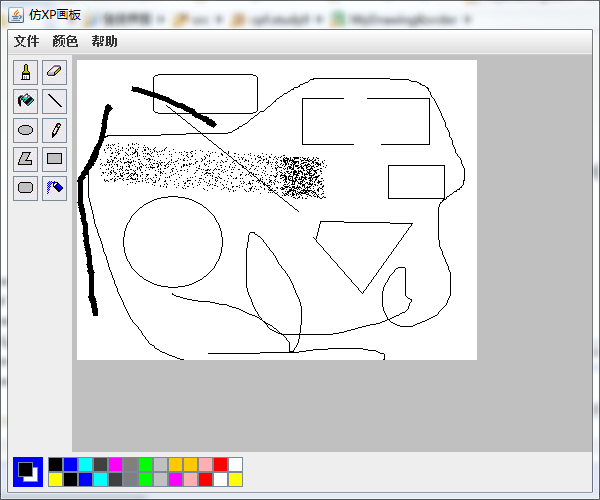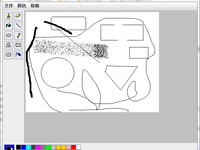这是一个仿XP的
画图板,再
重绘的基础上可以实现基本的画图、橡皮檫、画多边形、圆等等功能,并且可以左右键点击画图画出不同颜色。
实现思路:将整个画图板分为5块来实现 : 1、
主界面 ( MyDrawingBorder) 2、
监听器(DrawingListener) 3、画图面板(DrawingPanel) 4、颜色板块(ColorPanel) 5、工具板块(ToolsPanel) ,最后将后面的4个板块整合到主界面上。
完整代码见附件
画图板实现:
1、创建主界面 ( MyDrawingBorder) :
设置主界面大小、创建菜单栏、布局格式等等,并将各个板块整合在一起
class="java">
private void init() {
this.setTitle("仿XP画板");
this.setSize(new Dimension(600, 500));
this.setLocationRelativeTo(null);
this.setDefaultCloseOperation(3);
this.setLayout(new BorderLayout());
// 调用创建菜单栏的方法,获取到菜单栏的对象
JMenuBar jmb = createMenuBar();
// 将菜单栏的对象设置为窗体的菜单栏
this.setJMenuBar(jmb);
// 实例化ToolsPanel类的对象,该对象要添加到窗体西边
ToolsPanel tp = new ToolsPanel();
this.add(tp, BorderLayout.WEST);
// 实例化ColorPanel类的对象,该对象要添加到窗体南边
ColorPanel cp = new ColorPanel();
this.add(cp, BorderLayout.SOUTH)
// 实例化DrawingPanel类的对象,该对象要添加到窗体中边
DrawingPanel dp = new DrawingPanel();
this.add(dp, BorderLayout.CENTER);
this.setVisible(true);
//获取画图区域上的画布对象
JPanel panel = dp.getJPanel();
//实例化一个事件处理类的对象
DrawingListener dl = new DrawingListener(panel,tp,cp);
//给面板添加鼠标监听器方法
panel.addMouseListener(dl);
panel.addMouseMotionListener(dl);
// dl.getColor();
}
/**
* 创建菜单栏的方法
*
* @return 返回JMenuBar的对象
*/
private JMenuBar createMenuBar() {
// 实例化一个JMenuBar的对象
JMenuBar jmb = new JMenuBar();
// 菜单项的数组
String[] arrayMenu = { "文件", "颜色", "帮助" };
// 菜单子项的数组
String[][] arrayMenuItem = { { "新建", "保存", "打开", "退出" }, { "编辑颜色" },
{ "帮助主题", "关于画图" } };
// 根据数据循环来创建菜单栏
for (int i = 0; i < arrayMenu.length; i++) {
// 实例化一个JMenu的对象
JMenu menu = new JMenu(arrayMenu[i]);
// 将menu添加到jmb对象中
jmb.add(menu);
for (int j = 0; j < arrayMenuItem[i].length; j++) {
// 实例化JMenuItem的对象
JMenuItem jmi = new JMenuItem(arrayMenuItem[i][j]);
// 将jmi对象添加到menu中
menu.add(jmi);
}
}
return jmb;
}
2、 监听器(DrawingListener): 监听动作,画图
public class DrawingListener extends MouseAdapter {
//定义存储坐标的属性
private int x0,y0,x1,y1,x2,y2, x3, y3, i =0,j=0;
private int c;
public static Boolean a=true;
private ToolsPanel tp;//用来获取图形的
private ColorPanel cp;//用来获取颜色的
private Graphics g;//用来画图的
private Color color;//用来存储前景色和背景色
private JPanel panel; //hua tu ban de dui xiang
//robot lei
private Robot robot;
private Rectangle rect;
/**
* 构造方法
* @param panel用来获取画布的
* @param tp用来获取图形的
* @param cp用来获取颜色的
*/
public DrawingListener(JPanel panel,ToolsPanel tp,ColorPanel cp){
g = panel.getGraphics();
this.panel = panel;
this.tp = tp;
this.cp = cp;
try {
robot = new Robot();
}catch (AWTException e){
e.printStackTrace();
}
}
/**
* 鼠标按下时执行的事件方法
*/
public void mousePressed(MouseEvent e) {
if(e.getButton() == 1){//左键,获取背景色
color = cp.getbColor();
}else if(e.getButton() ==3){//右键,获取前景色
color = cp.getfColor();
}
//获取按下的坐标
x1 = e.getX();
y1 = e.getY();
}
/**
* 鼠标释放时执行的事件方法
*/
public void mouseReleased(MouseEvent e) {
a= false;
Graphics2D g2 = (Graphics2D) g;
//获取释放的坐标
x2 = e.getX();
y2 = e.getY();
//设置颜色
Color a = g2.getBackground();
//设置画图的颜色
g.setColor(color);
//判断是否是直线
if( tp.getValue().equals("line")){
g.drawLine(x1, y1, x2, y2);
}
else if (tp.getValue().equals("oval")){
g.drawOval(Math.min(x1,x2), Math.min(y1,y2) ,Math.abs(x2-x1),Math.abs(y1-y2));
}
else if(tp.getValue().equals("rect")){
g.drawRect(Math.min(x1,x2), Math.min(y1,y2) ,Math.abs(x2-x1),Math.abs(y1-y2));
}
else if(tp.getValue().equals("polygon")){
if (x3 == 0 && y3 == 0) {
g.drawLine(x1, y1, x2, y2);
x0 = x1;
y0 = y1;
x3 = x2;
y3 = y2;
} else {
g.drawLine(x3, y3, x2, y2);
x3 = x2;
y3 = y2;
}
if (c == 2) {
g.drawLine(x0, y0, x2, y2);
g.drawLine(x3, y3, x2, y2);
x3 = y3 = 0;
}
}
else if(tp.getValue().equals("roundrect")){
g.drawRoundRect(Math.min(x1,x2), Math.min(y1,y2) ,Math.abs(x2-x1),Math.abs(y1-y2), Math.abs(x2-x1)/5, Math.abs(y1-y2)/5);
}
getColor();
}
// 监听鼠标拖拽操作
public void mouseDragged(MouseEvent e) {
Graphics2D g2 = (Graphics2D) g;
// 获取坐标
x2 = e.getX();
y2 = e.getY();
// 判断作图
if (tp.getValue().equals("pencil")) {
System.out.print(" ");
// g2.setStroke(new BasicStroke(1));
g.drawLine(x1, y1, x2, y2);
// 交换坐标
x1 = x2;
y1 = y2;
} else if (tp.getValue().equals("easer")) {
g2.setColor(Color.WHITE);
// g.fillRect(x2-20, y2-20, 40, 40);
g2.setStroke(new BasicStroke(20));
g2.drawLine(x1, y1, x2, y2);
// 交换坐标
x1 = x2;
y1 = y2;
g2.setStroke(new BasicStroke(1));
} else if (tp.getValue().equals("brush")) {
// g.fillOval(x1-5,y1-5,10,10);
g2.setStroke(new BasicStroke(5));
g2.drawLine(x1, y1, x2, y2);
// 交换坐标
x1 = x2;
y1 = y2;
g2.setStroke(new BasicStroke(1));
} else if (tp.getValue().equals("spray")) {
Random rand = new Random();
for (int i = 0; i < 60; i++) {
int w = rand.nextInt(4);
int p = rand.nextInt(20);
int q = rand.nextInt(20);
if (w == 1) {
g.drawLine(x2 + p, y2 + q, x2 + p, y2 + q);
} else if (w == 2) {
g.drawLine(x2 - p, y2 - q, x2 - p, y2 - q);
} else if (w == 3) {
g.drawLine(x2 + p, y2 - q, x2 + p, y2 - q);
} else {
g.drawLine(x2 - p, y2 + q, x2 - p, y2 + q);
}
}
}
}
//获取像素点
public void getColor(){
BufferedImage image = onScreen();
//定位高和宽在数组在数组中的位置
System.out.println("----->"+image.getWidth());
System.out.println("----->"+image.getHeight());
//遍历iamge
for ( i = 0;i <image.getWidth();i++){
for( j=0;j <image.getHeight();j++){
DrawingPanel.array[i][j] = image.getRGB(i,j);
}
}
}
//根据坐标获取颜色图像上的像素点
public int getColor(int x,int y){
//调用截屏
BufferedImage image = onScreen();
//返回对应像素的值
return image.getRGB(x, y);
}
//截屏方法,及返回图片
private BufferedImage onScreen(){
//获取到画图板的相对于屏幕的坐标
Point point = panel.getLocationOnScreen();
//实例化一个封装的矩形
Rectangle rect = new Rectangle((int)point.getX(),(int)point.getY(),panel.getWidth(), panel.getHeight() );
//截屏
BufferedImage image = robot.createScreenCapture(rect);
return image;
}
}
3画图面板(DrawingPanel)
设置画图区域的大小 和重绘
/**
* 画图区域面板的实现类,该类继承自JPanel类
*
* @author Administrator
*
*/
public class DrawingPanel extends JPanel {
/**
* 构造方法
*/
public DrawingPanel() {
init();// 调用初始化面板的方法
}
// 实例化一个JPanel类的对象属性,用来获取画布
private JPanel panel = new JPanel(){
//方法重写
public void paint(Graphics g){
super.paint(g);
if(DrawingListener.a==false){
for(int i=0;i < array.length;i++){
for(int j =0;j<array[i].length;j++){
Color color = new Color(array[i][j]);
g.setColor(color);
g.drawLine(i, j, i, j);
}
}
}
}
};
//定义一个存画板上像素点的二维数组
public static int [][]array = new int [400][300];
/**
* 获取JPanel对象
*/
public JPanel getJPanel() {
return panel;
}
private void init() {
// 设置DrawingPanel的布局为流式布局布局
this.setLayout(new FlowLayout(FlowLayout.LEFT));
this.setBackground(Color.LIGHT_GRAY);
panel.setBackground(Color.WHITE);
panel.setPreferredSize(new Dimension(400, 300));
// 将panel添加到DrawingPanel上
this.add(panel);
}
}
4、工具面板(ToolsPanel )
public class ToolsPanel extends JPanel {
/**
* 构造方法
*/
public ToolsPanel() {
init();// 调用初始化面板的方法
}
//声明一个存储图形的属性
private String value = "line";
/**
* 获取图形属性的方法
*/
public String getValue(){
return value;
}
/**
* 定义一个匿名内部类
*/
private ActionListener al = new ActionListener() {
/**
* 事件处理方法
*/
public void actionPerformed(ActionEvent e) {
// 获取到事件源对象
// JButton btn = (JButton)e.getSource();
// 获取事件源的动作命令值
value = e.getActionCommand();
System.out.println("你选择的图形是:"+value);
}
};
private void init() {
// 设置ToolsPanel的布局为流式布局布局
this.setLayout(new FlowLayout());
// 实例化一个JPanel类的对象
JPanel panel = new JPanel();
// 设置panel的布局为网格布局
panel.setLayout(new GridLayout(5, 2, 4, 4));
// 定义一个数组
String[] array = { "image/brush.jpg", "image/easer.jpg",
"image/fillRect.jpg", "image/line.jpg", "image/oval.jpg",
"image/pencil.jpg", "image/polygon.jpg", "image/rect.jpg",
"image/roundrect.jpg", "image/spray.jpg" };
// 根据数组循环实例化按钮对象
for (int i = 0; i < array.length; i++) {
// 实例化一个ImageIcon的对象
ImageIcon image = new ImageIcon(array[i]);
// 实例化按钮对象,并设置按钮的图标
JButton btn = new JButton(image);
// 截取图片的名字
String fileName = array[i].substring(
array[i].indexOf("/") + 1,
array[i].lastIndexOf(".jpg"));
//设置按钮的动作命令值
btn.setActionCommand(fileName);
// 设置按钮的大小
btn.setPreferredSize(new Dimension(25, 25));
//给按钮添加动作监听器方法,绑定动作事件处理类的对象al
btn.addActionListener(al);
// 将按钮添加到panel上
panel.add(btn);
}
// 将panel添加到ToolsPanel上
this.add(panel);
}
}
5\颜色面板( ColorPanel)
public class ColorPanel extends JPanel {
/**
* 构造方法
*/
public ColorPanel() {
init();// 调用初始化面板的方法
}
// 定义一个背景色属性和前景色属性
private Color bColor = Color.BLACK, fColor = Color.WHITE;
/**
* 获取背景色
*/
public Color getbColor() {
return bColor;
}
/**
* 获取前景色
*/
public Color getfColor() {
return fColor;
}
private void init() {
// 设置ColorPanel的布局为流式布局布局
this.setLayout(new FlowLayout(FlowLayout.LEFT));
// 实例化一个JPanel类的对象
JPanel panelFB = new JPanel();
panelFB.setBackground(Color.BLUE);
panelFB.setPreferredSize(new Dimension(30, 30));
// 设置panel的布局为空布局
panelFB.setLayout(null);
final JButton btnB = new JButton();
btnB.setBackground(Color.BLACK);
btnB.setBounds(5, 5, 15, 15);
final JButton btnF = new JButton();
btnF.setBackground(Color.WHITE);
btnF.setBounds(10, 10, 15, 15);
panelFB.add(btnB);
panelFB.add(btnF);
this.add(panelFB);
/**
* 定义一个匿名内部类
*/
MouseAdapter ml = new MouseAdapter() {
/**
* 鼠标按下时的事件处理方法
*/
public void mousePressed(MouseEvent e) {
// 获取到事件源对象
JButton btn = (JButton) e.getSource();
// e.getButton()返回的值是1表示是左键,如果是3表示右键,如果是2表示滚轮的
if (e.getButton() == 1) {
// 获取到按钮上的背景色
bColor = btn.getBackground();
btnB.setBackground(bColor);//设置按钮的背景色
System.out.println("你选择的颜色是:" + bColor);
} else if (e.getButton() == 3) {
// 获取到按钮上的背景色
fColor = btn.getBackground();
btnF.setBackground(fColor);//设置按钮的背景色
System.out.println("你选择的颜色是:" + fColor);
}
}
};
// 实例化一个JPanel类的对象
JPanel panel = new JPanel();
// 设置panel的布局为网格布局
panel.setLayout(new GridLayout(2, 12));
// 定义一个颜色数组
Color[] array = { Color.BLACK, Color.BLUE, Color.CYAN, Color.DARK_GRAY,
Color.MAGENTA, Color.GRAY, Color.GREEN, Color.LIGHT_GRAY, Color.ORANGE,
Color.orange, Color.PINK, Color.RED, Color.WHITE, Color.YELLOW,
Color.black, Color.blue, Color.cyan, Color.darkGray, Color.gray,
Color.green, Color.lightGray, Color.magenta, Color.pink, Color.red,
Color.white, Color.yellow };
// 根据数组循环实例化按钮对象
for (int i = 0; i < array.length; i++) {
// 实例化按钮对象,并设置按钮的图标
JButton btn = new JButton();
// 设置按钮的背景色
btn.setBackground(array[i]);
// 设置按钮的大小
btn.setPreferredSize(new Dimension(15, 15));
// 给事件源btn按钮添加鼠标监听器方法,绑定事件处理类的对象al
btn.addMouseListener(ml);
// 将按钮添加到panel上
panel.add(btn);
}
// 将panel添加到ColorPanel上
this.add(panel);
}
}
实现图片


- 大小: 40.1 KB
- 画图板.rar (25.3 KB)
- 下载次数: 0
